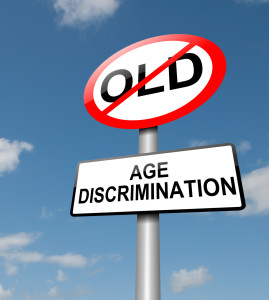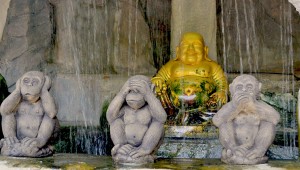by Brian | Apr 25, 2016 | Wellness Matters

What comes to your mind when you see or hear the word “spiritual”? A common answer is that it refers to religion or religious beliefs.
Everyone has a spiritual component, but not everyone is religious. A comparison of the two is provided by the Merck Manual: “Religion and spirituality are similar but not identical concepts. Religion is often viewed as more institutionally based, more structured, and more traditional and may be associated with organized, well-established beliefs. Spirituality refers to the intangible and immaterial and thus may be considered a more general term, not associated with a particular group or organization. It can refer to feelings, thoughts, experiences, and behaviors related to the soul or to a search for the sacred (e.g., a Divine Being, Ultimate Reality, Ultimate Truth).” 1
The spiritual need for connection with the divine may be fulfilled in a community church, temple, mosque or other gathering place or a personal relationship with a higher power and may involve prayer, singing, meditation, chanting, fellowship, being alone or other. The main stipulation is that however you accomplish this; it does not harm yourself or others.
The next sections will look closer at connection and meaning, the two parts that make up spiritual wellness.
Connection
A definition of Spirituality provided by the University of Minnesota website states: “Spirituality is a broad concept with room for many perspectives. In general, it includes a sense of connection to something bigger than ourselves, and typically involves a search for meaning in life. As such, it is a universal human experience—something that touches us all. People may describe a spiritual experience as sacred or transcendent or simply a deep sense of aliveness and interconnectedness.”2
Spiritual wellness then relates to: developing a personal sense of connection to God and/or a power greater than ourselves and as a result create more meaning in our lives.
Positive inner states of peace, gratitude and hope are indicators that your efforts to find connection and meaning are succeeding.
Meaning
The second part of the spiritual dimension is how we derive meaning in our lives. This will differ for each person and change over time as our circumstances do.
Examples of how meaning can be experienced include but are not limited to:
- Religious or personal beliefs and practices that aim at connecting us to God or a higher power.
- Meaningful connection may also be found by spending time in nature, listening to music, artistic pursuits or other activities.
- Relationships with others can give our lives meaning.
- Meaning can also be experienced through working, both paid and unpaid
Meaningful connection usually results from a combination of activities in our lives. For my mother, her family was central for connection and meaning. She also cherished nature and music and believed in the power of prayer. This gave her life meaning and direction.
 Since ancient times the: “Native Americans follow their ancestors’ two purposes of life: to know the self and be of help to others. They vest many of their beliefs and spiritual powers in nature, the land, and animals.” 3 This provided the connection to something larger and is very different from the beliefs of Christianity or other forms of religion. These differences are an example of diversity and inclusion within free societies.
Since ancient times the: “Native Americans follow their ancestors’ two purposes of life: to know the self and be of help to others. They vest many of their beliefs and spiritual powers in nature, the land, and animals.” 3 This provided the connection to something larger and is very different from the beliefs of Christianity or other forms of religion. These differences are an example of diversity and inclusion within free societies.
Stepping back from our lives
A good place to return to as our lives change, is reflecting on the big picture questions. Examples of a few questions that I have pondered are listed below. I provided a sample of my answers to illustrate.
Why am I alive?
- Grow into my potential
- Do the best I can each day
- Build bridges to others to increase connection
- Develop compassion for myself and others
What do I find fulfilling in my life?
- Spending time with family and friends
- Living a wellness lifestyle
- Belonging to a spiritual community that provides connection
- Travelling and experiencing, embracing diversity
Where do I fit in?
- With others who are adventurous and into exploring their potential
- Sharing my creativity
- As part of the wellness community
Each person may have different answers depending on their spiritual perspective, there are no right or wrong responses. Answers to these or other questions can ground us and provide a spiritual foundation to build connection and meaning
Health, Longevity and Spiritual Wellness
There are many studies that correlate spiritual health with longevity, an example of these findings follow.
“Medicine has begun to recognize the strong influence of spirituality on health and illness. Studies of cancer patients have shown that those who continuously pursue goals related to living a meaningful life boost the natural killer cell activity in their immune systems.” 4
“Gerontology professionals agree that spirituality is important to older adults towards effective psychosocial function and successful aging.” 5
Our Spiritual needs are an important dimension of our wellbeing that influences our quality of life.
______________________________________________________________________________
References
1 Religion and Spirituality in the Elderly
Retrieved from: http://www.merckmanuals.com/professional/geriatrics/social_issues_in_the_elderly/religion_and_spirituality_in_the_elderly.html
2 Taking charge of your health and wellbeing
Created by the Center for Spirituality & Healing and Charlson Meadows. What Is Spirituality?
Retrieved from: http://www.takingcharge.csh.umn.edu/enhance-your- wellbeing/purpose/spirituality/what-spirituality
A collaboration between University of Minnesota-Center for Spirituality & Healing and Charlson Meadows renewal center
3 Spirituality and Aging
Retrieved from: http://cas.umkc.edu/casww/sa/spirituality.htm
4 Understanding Wellness
Retrieved from: Chapter 1, 5 Mauk, K. (2006). Gerontological Nursing: Competencies for Care. Sudbury, MA. Jones & Bartlett Publishers.
by Brian | Apr 2, 2016 | Ageism, Career Management
Countries such as Canada and the U.S.A. have largely abolished mandatory retirement and opened the gates for unretired Boomers to keep working. What lingers is possible age discrimination which will vary in degree, depending on the work setting.
For those un-retired workers who need or chose to keep working up to and past 65, ageism is a force that can work against your success in doing so.
Not only is age discrimination painful, it is unfair and can pose a barrier to finding or maintaining a job. It can also be experienced in settings other than the workplace.
 Work related ageism is due to long-held cultural beliefs and policies that we stop working at or before 65, because by this age we are too old to work. Granted in some cases workers are no longer competitively employable by or before 65.
Work related ageism is due to long-held cultural beliefs and policies that we stop working at or before 65, because by this age we are too old to work. Granted in some cases workers are no longer competitively employable by or before 65.
Human Rights and Discrimination
The Ontario Human Rights Commission describes age discrimination in employment as: “Assumptions and stereo-types about older workers are unfortunately all too prevalent in our workplaces. Older workers are often unfairly perceived as less productive, less committed to their jobs, not dynamic or innovative, un-receptive to change, unable to be trained or costly to the organization due to health problems and higher salaries. These ideas about older workers are simply myths that are not borne out by evidence. In fact, there is significant evidence that older workers:
- are highly-productive, offering considerable on the job experience;
- do as well or better than younger workers on creativity, flexibility, information processing, accident rates, absenteeism and turnover
- can learn as well as younger workers with appropriate training methods and environments
- and do not fear change but rather discrimination
In the United States, employment-related age discrimination charges can be filed through the US Equal Employment Opportunity Commission. In Canada the governing body is the Canadian Human Rights Commission.
Effects of Ageism and its Practice in the Workforce
Jen Laskey (2008) provides the following definition of Ageism and the psychological effects. “Ageism refers to a basic denial of older people’s human rights. The term was coined in 1968 by Robert N. Butler, M.D., a gerontologist, psychiatrist, and Pulitzer Prize–winning author. Like racism or sexism, ageism has a myriad of negative effects on emotional well-being. Age-based discrimination can decrease one’s self-esteem; it can cause feelings of stress, anxiety, guilt, shame, or helplessness. Others may also be quick to accept stereotypes about aging, thus compounding these effects.”
Alison Doyle, a job search expert advises that “Employment discrimination happens when a job seeker or an employee is treated unfavorably because of his or her race, skin color, national origin, gender, disability, religion, or age.”
The next paragraph is of particular interest to unretired Boomers:
How ageism is practiced is summarized by Kacey Stapleton (2009) in the following excerpt: “Ageism in the workplace is usually seen as a prejudice against anyone nearing or passing the standard age of retirement. Discrimination can either be systematic or incidental denial of employment, advancement or fair treatment. Systematic discrimination means an employer deliberately instructs management either against hiring individuals of a certain age or to force out workers as they near the age of retirement.”
Age discrimination can occur not only from a younger person towards an older one, but also in the other direction. Members of the older generation may view younger workers as inexperienced, or not reliable to name a few additional stereotypes, and values can clash. These types of discrimination issues can be found in the increasing number of inter-generational workplaces.
Beliefs Underlying Ageism
A post retrieved from the Older Adults-Aging in Canada website (2012) indicates that: “Older adults in the workplace are often perceived to be lower in productivity, slower in decision making, resistant to change, and slow to learn. Evidence suggests that this is not the case. Even with radical changes in technology and the expectations of faster and more intensified work, older workers are as productive as their younger counterparts with the appropriate training.
The central issue is not necessarily what your age is, but one of attitude of those perpetuating ageism. Read the list of six common stereotypes below and determine if they hold true for you. If so then it will become your homework to address them as need be.
- Have Reduced Learning Capacity
- Possess Outdated Skills
- Are Resistant to Change
- Demand Higher Wages
- Demonstrate Slower Decision- Making
- Have Lower Productivity
By confronting ageism in the labour market, un-retired Boomers may defuse this form of discrimination not only for themselves, but also the younger generations that follow.
Another option
I believe self-employment may give you more control as an older worker. I talk about this more in my book; “The Un-Retirement Guide” which is described under the Offering tab in this website.
by Brian | Feb 26, 2016 | Career Management, Unretirement

If so, you have joined the Un-Retired club which has many members!
“Un-Retirement” is the growing trend either by choice or economic necessity to continue to work past 65. This post will focus on those un-retired persons who need to keep working longer out of economic necessity.
It doesn’t matter whether your collar is blue, pink, green or white, Un-Retired Boomers come from all occupations and income levels.
White collar workers (those that perform professional, managerial, or administrative work) may have more formal education, and a higher working income, but they are not excluded from un-retirement. These workers can find themselves impacted by global market changes, forced layoff, or job loss for other causes with their retirement savings interrupted. The news media is filled with numerous stories:
- offshoring of white collar jobs and in some cases moving entire companies overseas;
- corporate downsizing and the resulting reduction of management positions; and
- automation through digital technologies with job redundancy or loss.
A large number of Un-Retired Boomers in North America never fit into the financial industry’s “freedom 50 Plus” model. This is due to the many personal and market events and circumstances that can prevent this from happening by or before, what was once the mandatory age of retirement at 65.
Zoomer Media Limited (2012) informs us “Data from Statistics Canada and the US Bureau of Labor Statistics confirms that a growing number of people are not retiring at age 65. In Canada, the percentage of participation in the labor force by people age 55 and up is at an all-time high. Experts believe the trend will continue, permanently wiping out the idea that 65 is a magic number signifying the end of the income-earning years. In both Canada and the USA, about 30% of people aged 65-69 are still working, either full time or part time. That age break captures only a tiny percentage of Baby Boomers, the oldest of whom just entered retirement age. The rest of the wave – now aged 47 to 64 – are still outside that traditional retirement benchmark. What will they do when they hit the number? The research is clear: they’ll keep right on working.”
Born between 1946 and 1964, there are approximately 76 million Baby Boomers in the USA and 10 million in Canada.
For the older worker who hasn’t accumulated enough assets to have the choice whether they want to keep working or not, the options are limited. Working longer (Un-Retired) and consuming less, saving more from any income derived is the primary strategy, ideally at a job you like and one that provides adequate compensation. This work could be in the form of part time, casual, seasonal, full time or self-employment, depending on the individual needs and employment situation.
Staying gainfully employed for an Un-Retired worker can be challenging enough if you are in good health. If a disabling health event occurs before a sufficient nest egg is established, then the strategy described above might not be available. This would depend on the severity of the disability and what level of recovery occurs. Working longer may not be possible and barring a windfall or other injection of funds, these folks essentially become unemployed and un-retired at whatever level their savings after the fact, allow. This may require downsizing and/or consolidation to reduce expenses or if there is debt with a decrease in standard of living.
There are Un-Retired individuals though, who work longer and achieve whatever their definition of financial freedom is, so all is not gloom and doom!
by Brian | Jul 1, 2015 | Musings, Wellness Matters
 During a recent trip to Thailand, I came across statues of the three wise monkeys. They were accompanied by a gold colored Buddha, set in a cave where a continuous stream of water fell from above, whose trickling sounds added a feeling of peace. I do not know the history behind this setting or how old it is. It was one of those coincidences we experience in our lives, as the three wise monkeys had been on my mind prior to travelling 12000 km and accidentally finding this special spot.
During a recent trip to Thailand, I came across statues of the three wise monkeys. They were accompanied by a gold colored Buddha, set in a cave where a continuous stream of water fell from above, whose trickling sounds added a feeling of peace. I do not know the history behind this setting or how old it is. It was one of those coincidences we experience in our lives, as the three wise monkeys had been on my mind prior to travelling 12000 km and accidentally finding this special spot.
I’m not the only one apparently, as there are many worldwide collectors of the different styles and materials used in producing statues, that depict the three wise monkeys.
It is not clear as to their origins, but it is thought to have occurred 400 years ago in Japan where the three monkeys are known as Mizaru, who covers his eyes and sees no evil; Kikazaru, who covers his ears and who hears no evil; and Iwazaru, who covers his mouth and speaks no evil.
In Buddhist tradition, the proverb is about not dwelling on evil thoughts. Depending on the country, there are various meanings attached to the three wise monkeys that relate to being of good mind, speech and action.
It may also signify a code of silence in gangs, or organized crime.
Monkeys have been held sacred and/or in high esteem for centuries: the Hanuman Languor in India, the Rhesus Macaque in China and the Japanese Macaque (Snow Monkey) in Japan. Monkey folklore existed centuries before Taoism, Buddhism or Confucianism.
Mahatma Gandhi was the leader of the Indian independence movement and among other attributes, author of the Seven Social Sins. The one notable exception to his lifestyle of non-possession was a small statue of the three monkeys. There seems to be a parallel between Gandhi’s seven social sins and the proverb of the three wise monkeys. The photo below was taken at the tomb site of Mr. Gandhi in New Delhi, India. Proverbs are used in numerous cultures, the most well known source being the Book of Proverbs in the Bible.

by Brian | Jun 21, 2015 | The Boomer Generation, Unretirement
 The Baby Boomers and the X, Y, Z generations largely make up the working population in the USA or Canada.
The Baby Boomers and the X, Y, Z generations largely make up the working population in the USA or Canada.
The latest capital letter of the alphabet added to describe the generations is “U” This applies to those un-retired Boomers who can’t afford to stop working or who can by 65 but prefer not to.
The upside is that work can provide a connection with others, a sense of purpose and structure, benefit plans, additional income and so on. This is especially true if your job is a match for your financial needs, strengths, and interests.
At the other end of the continuum; the reverse can also be true where certain employment conditions do not meet our financial needs or match our interests.
Talking about change or lack of, agencies like Statistics Canada and the US Census still refer to 65 as the age of retirement, when mandatory retirement at 65 was repealed in 2012 by Canada and 1986 in the U.S.
Results from the Ipsos Reid poll conducted for the 2014 Sun Life Canadian Unretirement Index found that: “As we have seen in past years, those who plan to work past 65 fall into two camps. Thirty-five per cent say they’ll do so because they want to. Sixty-five per cent feel they will need to. The gap between the two has been gradually widening since 2011.”
In the US, labor market participation rates of people 65 years and older has increased and according to the United States Census Bureau (2013) : “Within the 65 and over population, 65 to 69-year-olds saw the largest change, increasing from 21.8 percent in 1990 to 30.8 percent in 2010.”
There is a publication found on the United States Census Bureau (2022) website titled; On The Population 65 Years and Older in the United States ( 2016). “This report provides a look at selected demographic, social, housing and economic characteristics of the 65 years and older population in the United States based on a 2016 American Community Survey (ACS) one-year of data.”
On page 2 of this report the following is stated about Boomers working over 65: “In addition to the older population being a larger segment of the U.S. population, many of the social norms associated with old age have changed in recent years. Individuals are remaining in the labor force past the typical retirement age of 65.” On page 16 of this report the authors also advise ; “This is particularly visible for the 65 to 74 age group, in which around 30 percent of males and 22 percent of females were in the labor force.”. The numbers in this survey report appear similar to those reported in 2013 above, based on the 2016 American Community Survey (ACS) one-year data.
The demographics or age of the working population is dynamic, changing over the years. It is 2023 as I add this sentence and the changes are evident, I’m writing a new post to reflect these changes for interested readers!
 Since ancient times the: “Native Americans follow their ancestors’ two purposes of life: to know the self and be of help to others. They vest many of their beliefs and spiritual powers in nature, the land, and animals.” 3 This provided the connection to something larger and is very different from the beliefs of Christianity or other forms of religion. These differences are an example of diversity and inclusion within free societies.
Since ancient times the: “Native Americans follow their ancestors’ two purposes of life: to know the self and be of help to others. They vest many of their beliefs and spiritual powers in nature, the land, and animals.” 3 This provided the connection to something larger and is very different from the beliefs of Christianity or other forms of religion. These differences are an example of diversity and inclusion within free societies.






